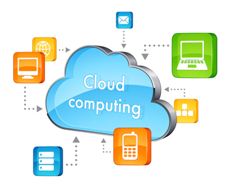
Small businesses spend significant money on IT infrastructure. Traditionally, they have owned the IT assets themselves and have to carry the burden of capital purchase and ongoing maintenance cost. However, there is a paradigm shift occurring in the IT industry with what is commonly known as cloud computing. This has the potential to dramatically change the way small businesses operate their IT infrastructure. With cloud computing small businesses no longer need to own the IT assets themselves. Instead, they can rent these assets on as needed basis and only pay for what they use. You can think of this as analogous to buying electricity from utility company.
Cloud computing significantly changes the economics of IT budget for small business owners. The core of this revolves around cost savings and it helps small business by:
- Lowering the opportunity cost of running technology
- Prioritizing operating expenditure over capital expenditure
- Bringing down total cost of ownership of the infrastructure
- Adding business value with reinvigorated focus on the core activities
Infrastructural comparison
For small businesses, traditional IT expenditures are capital intensive. This is because they need to purchase the hardware as well as software licenses outright.
Offsite infrastructure works on a recurring expenditure model. Businesses do not need to spend money upfront to purchase the assets. It serves as a standard operating expense, and also as insurance against server outages. For example, Amazon’s East Coast data center suffered an outage in August, which caused a lot of problems for small businesses using their service. However, companies that became victims of the outage in the East Coast could have easily avoided the loss if they had an offsite backup on the West Coast. Businesses operating in the west might consider colo San Diego or Los Angeles as their hub, but there is nothing to stop their eastern counterparts from also taking advantage of this facility. In fact, companies that have a nation-wide presence would be smart to have multiple colocation hubs in different regions.
How does it benefit small businesses from financial viewpoint?
First of all, it gives them flexibility to terminate the cost at will. With the capital purchase in the traditional model business owners are stuck with ongoing operating cost whether they are fully utilizing the assets or not. In addition, the depreciation and financing costs are not incurred in the offsite model.
In a classic study conducted by O’Reilly to compare internal IT versus offsite infrastructure, it was shown that in the latter case, savings amounted to approximately 29%. Most important, there is no capital investment required in the offsite case.
Total cost of ownership is also an important consideration for small businesses. With the offsite infrastructure model this cost drops significantly. When it comes to offsite options such as the cloud, businesses have several pricing options available. They are based on well-defined metrics such as the RAM, storage, security, colocation and bandwidth.
In the case of on-premise, or traditional solutions, businesses incur direct costs, indirect costs and overhead costs. Compare this with a Southern California company opting for colocation San Diego, as mentioned in the previous example, where there is no additional cost of network and storage infrastructure.
An on-premise solution would require power, floor space, storage and IT operations, adding to the overall cost. Also, there are network and storage infrastructure indirect costs for managing the general operations of the enterprise. Finally, there is the overhead cost of owning servers.
This analysis clearly shows that the cost of ownership in the case of offsite infrastructure is not only lower, but it also offers greater flexibility. Moreover, it allows the small business to shift its focus towards running the businesses instead of worrying about managing IT infrastructure. Netflix understands this and has taken advantage of Amazon’s cloud infrastructure to run its movie streaming services.
Small businesses should revisit their IT model and consider moving to offsite infrastructure to lower their costs, gain flexibility and achieve stability and connectivity of their data centers.






